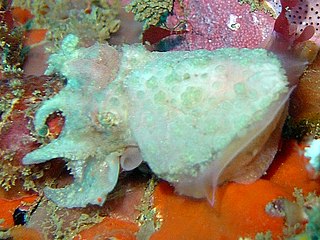
Sepia bidhaia is a species of cuttlefish native to the southwestern Pacific Ocean, specifically the waters off the Great Barrier Reef. It lives at a depth of between 200 and 304 m.
Sepia chirotrema is a species of cuttlefish native to the southern Indo-Pacific, specifically from Investigator Strait, southern Australia to Dirk Hartog Island, western Australia. It lives at a depth of between 120 and 210 m.
Sepia cottoni is a species of cuttlefish native to the southeastern Indian Ocean, specifically from northwest of Broome (17°31' S) to Armstrong Point, Rottnest Island (32°0' S). It lives at a depth of between 83 and 183 m.

Sepia dollfusi is a species of cuttlefish native to the Red Sea and southern part of the Suez Canal. The depth range of S. dollfusi is unknown. It has been recorded once in the Egyptian sector of the Mediterranean Sea, so it is potentially a Lessepsian migrant into the Mediterranean via the Suez Canal.
Sepia dubia is a species of cuttlefish native to the southeastern Atlantic Ocean. It is known only from the type locality, where it was caught at a depth of 25 m.
Sepia faurei is a species of cuttlefish native to the southwestern Indian Ocean, specifically to the east of the Cape of Good Hope, South Africa. It lives at depths to 168 m.
Sepia hieronis is a species of cuttlefish native to the southeastern Atlantic Ocean and southwestern Indian Ocean, specifically southern Namibia, from approximately 27°S to Port Alfred, South Africa, and east Africa from 17°S to Kenya and Mozambique. It is also present in the Saya-de-Malha Bank. It lives at depths of between 43 and 500 m, although it is most abundant at 110 to 250 m depth.
Sepia insignis is a species of cuttlefish native to the southwestern Indian Ocean, specifically South Africa, from the Cape of Good Hope to Natal. It lives at depths to 42 m.
Sepia ivanovi is a species of cuttlefish native to the southwestern Indian Ocean, probably throughout southeast Africa, including Kenya, Mozambique, to the mouth of the Zambezi River. It lives at depths to 50 m.
Sepia joubini is a species of cuttlefish native to the southwestern Indian Ocean, specifically South Africa, off Tugela River Mouth, to Cape Natal, off southern Mozambique, and in the Saya-de-Malha Bank. It lives at a depth of between 66 and 170 m.
Sepia koilados is a species of cuttlefish native to the southeastern Indian Ocean, specifically the North West Shelf in western Australia. It lives at depths of between 182 and 203 m.
Sepia limata is a species of cuttlefish native to the southwestern Pacific Ocean, specifically southern Queensland to New South Wales, Australia. It lives at depths of between 17–183 metres (56–600 ft).
Sepia mira is a species of cuttlefish native to the southwestern Pacific Ocean, specifically from the mouth of Clarence River, New South Wales to off Wooli in Australia. It lives at depths of between 20 and 72 m.

Sepia novaehollandiae is a species of cuttlefish native to the southern Indo-Pacific. Its natural range stretches from Shellharbour, New South Wales to North West Shelf in Western Australia. It lives at depths of between 15 and 348 m.
Sepia plana is a species of cuttlefish native to the coast of Australia, specifically the North West Shelf. However, cuttlebones of this species have also been found off eastern Australia, suggesting that it may have a wider distribution. S. plana lives at depths of between 396 and 505 m.
Sepia rhoda is a species of cuttlefish native to the Indo-Pacific, specifically from the Arafura Sea to the North West Shelf, both off Australia. It lives at depths of between 64 and 184 m.
Sepia saya is a species of cuttlefish known only from its type locality in the southwestern Indian Ocean. It lives at depths of 87 to 117 m.
Sepia senta is a species of cuttlefish native to the southeastern Indian Ocean, specifically the North West Shelf in Western Australia. It is possibly also present in Indonesia. Reid et al. (2005) note that "a very similar, probably closely related animal has been found in the Philippines". S. senta lives at depths of 256 to 426 m.

Sepia tuberculata is a species of cuttlefish native to South African waters from Melkbosstrand to Knysna. It belongs to the genus Sepia. It lives in very shallow water to a depth of 3 m. It is endemic.
Sepia vercoi is a species of cuttlefish native to the southeastern Indian Ocean, specifically the waters off Western Australia. It lives at depths of 76 to 201 m.




